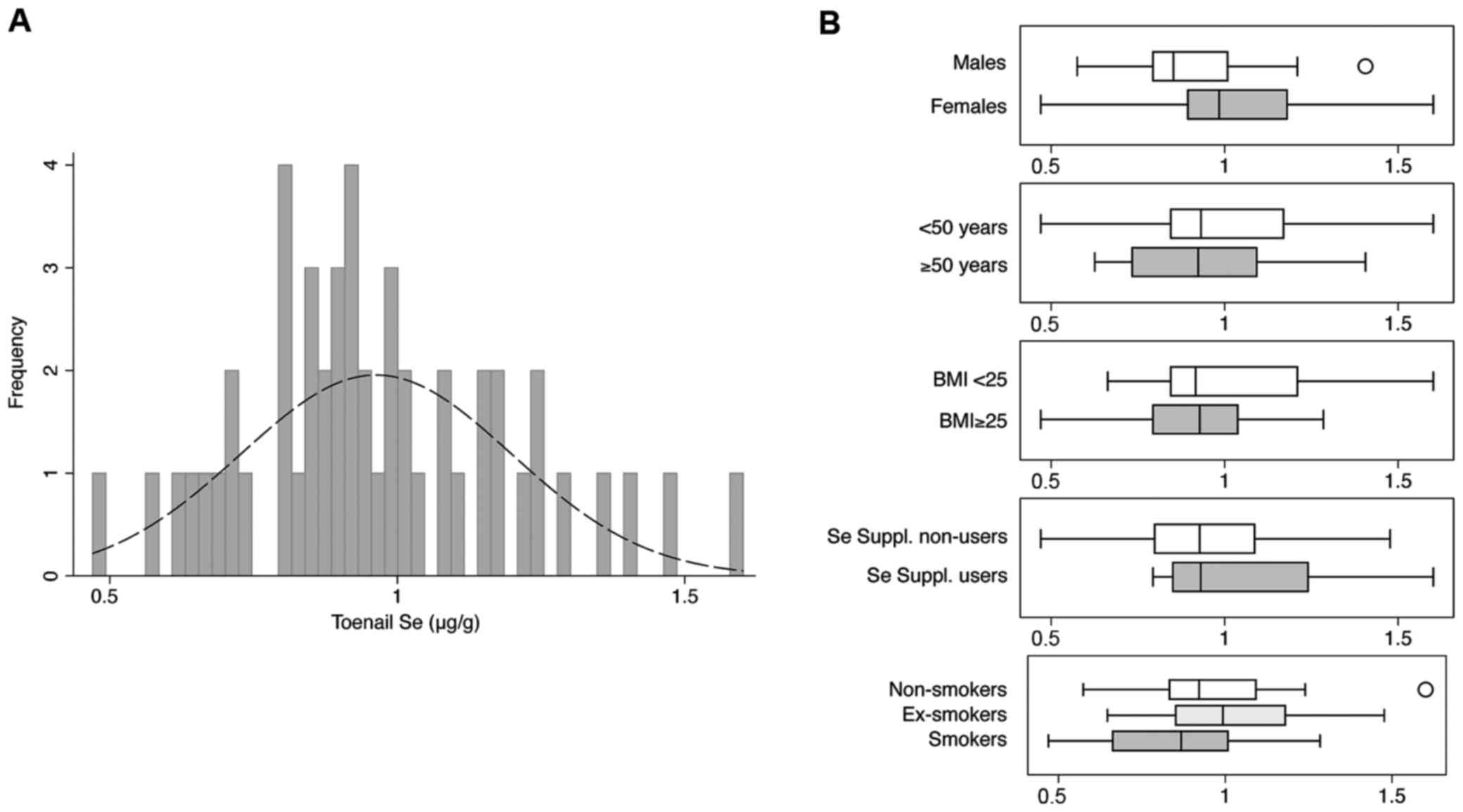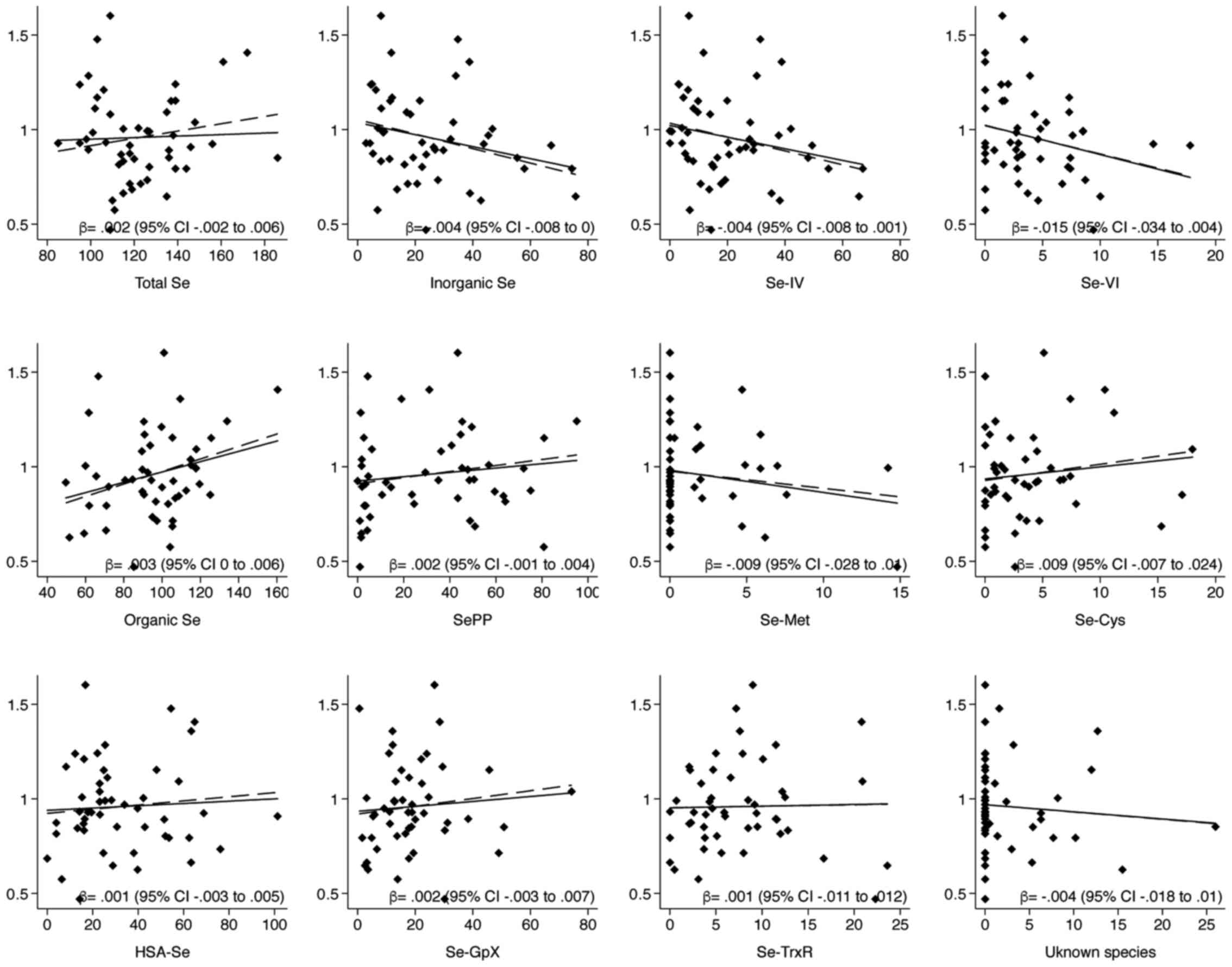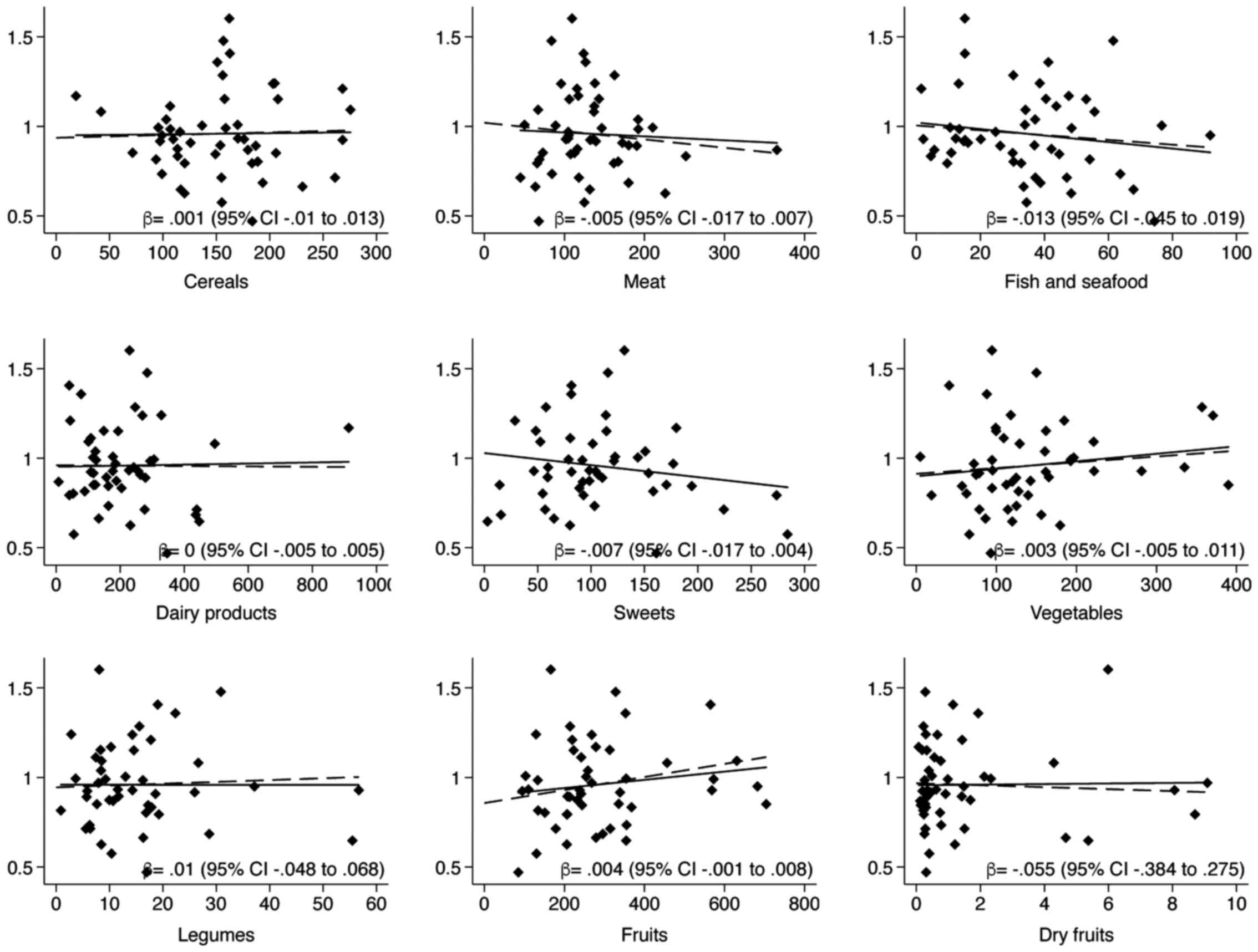|
1
|
Vinceti M, Dennert G, Crespi CM, Zwahlen
M, Brinkman M, Zeegers MP, Horneber M, DAmico R and Del Giovane C:
Selenium for preventing cancer. Cochrane Database Syst Rev.
3:CD0051952014.
|
|
2
|
Vinceti M and Rothman KJ: More results but
no clear conclusion on selenium and cancer. Am J Clin Nutr.
104:245–246. 2016. View Article : Google Scholar : PubMed/NCBI
|
|
3
|
Jablonska E and Vinceti M: Selenium and
human health: witnessing a copernican revolution? J Environ Sci
Health C Environ Carcinog Ecotoxicol Rev. 33:328–368. 2015.
View Article : Google Scholar : PubMed/NCBI
|
|
4
|
Vinceti M, Burlingame B, Filippini T,
Naska A, Bargellini A and Borella P: The epidemiology of selenium
and human healthSelenium: Its Molecular Biology and Role in Human
Health. Hatfield DL, Schweizer U, Tsuji PA and Gladyshev VN:
Springer International Publishing; Cham: pp. 365–376. 2016,
View Article : Google Scholar
|
|
5
|
Tsongas TA and Ferguson SW: Human health
effects of selenium in a rural Colorado drinking water supply. In:
Trace Substances in Environmental Health-XIA Symposium. Hemphill
DD: University of Missouri; Columbia: pp. 30–35. 1977
|
|
6
|
Valentine JL: Environmental occurrence of
selenium in waters and related health significance. Biomed Environ
Sci. 10:292–299. 1997.PubMed/NCBI
|
|
7
|
Vinceti M, Ballotari P, Steinmaus C,
Malagoli C, Luberto F, Malavolti M and Rossi Giorgi P: Long-term
mortality patterns in a residential cohort exposed to inorganic
selenium in drinking water. Environ Res. 150:348–356. 2016.
View Article : Google Scholar : PubMed/NCBI
|
|
8
|
Ito K, Mathes R, Ross Z, Nádas A, Thurston
G and Matte T: Fine particulate matter constituents associated with
cardiovascular hospitalizations and mortality in New York City.
Environ Health Perspect. 119:467–473. 2011. View Article : Google Scholar : PubMed/NCBI
|
|
9
|
Heck JE, Park AS, Qiu J, Cockburn M and
Ritz B: Risk of leukemia in relation to exposure to ambient air
toxics in pregnancy and early childhood. Int J Hyg Environ Health.
217:662–668. 2014. View Article : Google Scholar : PubMed/NCBI
|
|
10
|
Mariottini E, Capel R and Grasso Bigazzi
C: Selenium content in foods. J Prev Med Hyg. 36:55–60. 1995.
|
|
11
|
Lombardi-Boccia G, Aguzzi A, Cappelloni M,
Di Lullo G and Lucarini M: Total-diet study: dietary intakes of
macro elements and trace elements in Italy. Br J Nutr.
90:1117–1121. 2003. View Article : Google Scholar : PubMed/NCBI
|
|
12
|
Shacklette HT and Boerngen JG: Element
concentrations in soils and other surficial materials of the
conterminous United States. U.S. Geological Paper 1270United States
Goverment Printing Office. Washington: 1984
|
|
13
|
Terry N, Zayed AM, De Souza MP and Tarun
AS: Selenium in higher plants. Annu Rev Plant Physiol Plant Mol
Biol. 51:401–432. 2000. View Article : Google Scholar : PubMed/NCBI
|
|
14
|
Satia JA, King IB, Morris JS, Stratton K
and White E: Toenail and plasma levels as biomarkers of selenium
exposure. Ann Epidemiol. 16:53–58. 2006. View Article : Google Scholar : PubMed/NCBI
|
|
15
|
Combs GF Jr, Watts JC, Jackson MI, Johnson
LK, Zeng H, Scheett AJ, Uthus EO, Schomburg L, Hoeg A, Hoefig CS,
et al: Determinants of selenium status in healthy adults. Nutr J.
10:752011. View Article : Google Scholar : PubMed/NCBI
|
|
16
|
EFSA Panel on Dietetic Products, Nutrition
and Allergies (NDA): Scientific opinion on dietary reference values
for selenium. EFSA. 12:1–67. 2014.
|
|
17
|
Vinceti M, Crespi CM, Malagoli C, Del
Giovane C and Krogh V: Friend or foe? The current epidemiologic
evidence on selenium and human cancer risk. J Environ Sci Health C
Environ Carcinog Ecotoxicol Rev. 31:305–341. 2013. View Article : Google Scholar : PubMed/NCBI
|
|
18
|
Vinceti M, Grill P, Malagoli C, Filippini
T, Storani S, Malavolti M and Michalke B: Selenium speciation in
human serum and its implications for epidemiologic research: a
cross-sectional study. J Trace Elem Med Biol. 31:1–10. 2015.
View Article : Google Scholar : PubMed/NCBI
|
|
19
|
Skalny AV, Simashkova NV, Klyushnik TP,
Grabeklis AR, Radysh IV, Skalnaya MG and Tinkov AA: Analysis of
hair trace elements in children with autism spectrum disorders and
communication disorders. Biol Trace Elem Res. Oct 26–2016.(Epub
ahead of print). View Article : Google Scholar
|
|
20
|
Ovaskainen ML, Virtamo J, Alfthan G,
Haukka J, Pietinen P, Taylor PR and Huttunen JK: Toenail selenium
as an indicator of selenium intake among middle-aged men in an area
with low soil selenium. Am J Clin Nutr. 57:662–665. 1993.PubMed/NCBI
|
|
21
|
Longnecker MP, Stram DO, Taylor PR,
Levander OA, Howe M, Veillon C, McAdam PA, Patterson KY, Holden JM,
Morris JS, et al: Use of selenium concentration in whole blood,
serum, toenails, or urine as a surrogate measure of selenium
intake. Epidemiology. 7:384–390. 1996. View Article : Google Scholar : PubMed/NCBI
|
|
22
|
Yaemsiri S, Hou N, Slining MM and He K:
Growth rate of human fingernails and toenails in healthy American
young adults. J Eur Acad Dermatol Venereol. 24:420–423. 2010.
View Article : Google Scholar : PubMed/NCBI
|
|
23
|
Krogh V, Pala V, Vinceti M, Berrino F,
Ganzi A, Micheli A, Muti P, Vescovi L, Ferrari A, Fortini K, et al:
Toenail selenium as biomarker: reproducibility over a one-year
period and factors influencing reproducibility. J Trace Elem Med
Biol. 17:(Suppl 1). 31–36. 2003.PubMed/NCBI
|
|
24
|
Hunter DJ, Morris JS, Chute CG, Kushner E,
Colditz GA, Stampfer MJ, Speizer FE and Willett WC: Predictors of
selenium concentration in human toenails. Am J Epidemiol.
132:114–122. 1990. View Article : Google Scholar : PubMed/NCBI
|
|
25
|
van den Brandt PA, Goldbohm RA, vant Veer
P, Bode P, Hermus RJ and Sturmans F: Predictors of toenail selenium
levels in men and women. Cancer Epidemiol Biomarkers Prev.
2:107–112. 1993.PubMed/NCBI
|
|
26
|
Morris JS, Spate VL and Ngwenyama RA:
Determinants of selenium in the toenail biomonitor. J Radioanal
Nucl Chem. 269:283–290. 2006. View Article : Google Scholar
|
|
27
|
Park K, Rimm E, Siscovick D, Spiegelman D,
Morris JS and Mozaffarian D: Demographic and lifestyle factors and
selenium levels in men and women in the U.S. Nutr Res Pract.
5:357–364. 2011. View Article : Google Scholar : PubMed/NCBI
|
|
28
|
Filippini T, Michalke B, Malagoli C, Grill
P, Bottecchi I, Malavolti M, Vescovi L, Sieri S, Krogh V, Cherubini
A, et al: Determinants of serum cadmium levels in a Northern Italy
community: a cross-sectional study. Environ Res. 150:219–226. 2016.
View Article : Google Scholar : PubMed/NCBI
|
|
29
|
Bergomi M, Vinceti M, Nacci G, Pietrini V,
Brätter P, Alber D, Ferrari A, Vescovi L, Guidetti D, Sola P, et
al: Environmental exposure to trace elements and risk of
amyotrophic lateral sclerosis: a population-based case-control
study. Environ Res. 89:116–123. 2002. View Article : Google Scholar : PubMed/NCBI
|
|
30
|
Vinceti M, Bassissi S, Malagoli C,
Pellacani G, Alber D, Bergomi M and Seidenari S: Environmental
exposure to trace elements and risk of cutaneous melanoma. J Expo
Anal Environ Epidemiol. 15:458–462. 2005. View Article : Google Scholar : PubMed/NCBI
|
|
31
|
Vinceti M, Venturelli M, Sighinolfi C,
Trerotoli P, Bonvicini F, Ferrari A, Bianchi G, Serio G, Bergomi M
and Vivoli G: Case-control study of toenail cadmium and prostate
cancer risk in Italy. Sci Total Environ. 373:77–81. 2007.
View Article : Google Scholar : PubMed/NCBI
|
|
32
|
Pala V, Sieri S, Palli D, Salvini S,
Berrino F, Bellegotti M, Frasca G, Tumino R, Sacerdote C, Fiorini
L, et al: Diet in the Italian EPIC cohorts: presentation of data
and methodological issues. Tumori. 89:594–607. 2003.PubMed/NCBI
|
|
33
|
Malavolti M, Malagoli C, Fiorentini C,
Longo C, Farnetani F, Ricci C, Albertini G, Lanzoni A, Reggiani C,
Virgili A, et al: Association between dietary vitamin C and risk of
cutaneous melanoma in a population of Northern Italy. Int J Vitam
Nutr Res. 83:291–298. 2013. View Article : Google Scholar : PubMed/NCBI
|
|
34
|
Malagoli C, Malavolti M, Agnoli C, Crespi
CM, Fiorentini C, Farnetani F, Longo C, Ricci C, Albertini G,
Lanzoni A, et al: Diet quality and risk of melanoma in an Italian
population. J Nutr. 145:1800–1807. 2015. View Article : Google Scholar : PubMed/NCBI
|
|
35
|
Heitland P: Selenium in serum. In: The MAK
Collection for Occupational Health and SafetyPart IV: Biomonitoring
Methods. 13. Wiley-VCH; Germany: pp. 249–263. 2013
|
|
36
|
Michalke B and Berthele A: Contribution to
selenium speciation in cerebrospinal fluid samples. J Anal At
Spectrom. 26:165–170. 2011. View Article : Google Scholar
|
|
37
|
Solovyev N, Berthele A and Michalke B:
Selenium speciation in paired serum and cerebrospinal fluid
samples. Anal Bioanal Chem. 405:1875–1884. 2013. View Article : Google Scholar : PubMed/NCBI
|
|
38
|
Xu M, Yang LM and Wang QQ: Quantification
of selenium-tagged proteins in human plasma using
species-unspecific isotope dilution ICP-DRC-qMS coupled on-line
with anion exchange chromatography. J Anal At Spectrom.
23:1545–1549. 2008. View Article : Google Scholar
|
|
39
|
Turrini A, Saba A, Perrone D, Cialfa E and
DAmicis A: Food consumption patterns in Italy: the INN-CA study
1994–1996. Eur J Clin Nutr. 55:571–588. 2001. View Article : Google Scholar : PubMed/NCBI
|
|
40
|
Willett W: Nutritional epidemiology. 3rd.
Oxford University Press; New York: 2013
|
|
41
|
Filippini T, Michalke B, Grill P, Malagoli
C, Malavolti M, Vescovi L and Sieri S: Determinants of serum
manganese levels in an Italian population. Mol Med Rep. (In
press).
|
|
42
|
Baskett CK, Spate VL, Mason MM, Nichols
TA, Williams A, Dubman IM, Gudino A, Denison J and Morris JS:
Long-term selenium status in humans. J Radioanal Nucl Chem.
249:429–435. 2001. View Article : Google Scholar
|
|
43
|
Kanabrocki EL, Kanabrocki JA, Greco J,
Kaplan E, Oester YT, Brar SS, Gustafson PS, Nelson DM and Moore CE:
Instrumental analysis of trace elements in thumbnails of human
subjects. Sci Total Environ. 13:131–140. 1979. View Article : Google Scholar : PubMed/NCBI
|
|
44
|
Xun P, Bujnowski D, Liu K, Morris JS, Guo
Z and He K: Distribution of toenail selenium levels in young adult
Caucasians and African Americans in the United States: the CARDIA
trace element study. Environ Res. 111:514–519. 2011. View Article : Google Scholar : PubMed/NCBI
|
|
45
|
Swanson CA, Longnecker MP, Veillon C, Howe
M, Levander OA, Taylor PR, McAdam PA, Brown CC, Stampfer MJ and
Willett WC: Selenium intake, age, gender, and smoking in relation
to indices of selenium status of adults residing in a seleniferous
area. Am J Clin Nutr. 52:858–862. 1990.PubMed/NCBI
|
|
46
|
Block RJ: The composition of keratins. The
amino acid composition of hair, wool, horn, and other eukeratins. J
Biol Chem. 128:181–186. 1939.
|
|
47
|
Magos L and Berg GG: SeleniumBiological
Monitoring of Toxic Metals. Clarkson TW, Friberg L, Nordberg GF and
Sager PR: Plenum Press; New York: pp. 383–405. 1988, View Article : Google Scholar
|
|
48
|
Dittmar M, Dindorf W and Banerjee A:
Organic elemental composition in fingernail plates varies between
sexes and changes with increasing age in healthy humans.
Gerontology. 54:100–105. 2008. View Article : Google Scholar : PubMed/NCBI
|
|
49
|
Schubert A, Holden JM and Wolf WR:
Selenium content of a core group of foods based on a critical
evaluation of published analytical data. J Am Diet Assoc.
87:285–299. 1987.PubMed/NCBI
|
|
50
|
Cappon CJ and Smith JC: Chemical form and
distribution of mercury and selenium in edible seafood. J Anal
Toxicol. 6:10–21. 1982. View Article : Google Scholar : PubMed/NCBI
|
|
51
|
Cappon CJ and Smith JC: Chemical form and
distribution of mercury and selenium in canned tuna. J Appl
Toxicol. 2:181–189. 1982. View Article : Google Scholar : PubMed/NCBI
|
|
52
|
Moreda-Piñeiro J, Moreda-Piñeiro A,
Romarís-Hortas V, Domínguez-González R, Alonso-Rodríguez E,
López-Mahía P, Muniategui-Lorenzo S, Prada-Rodríguez D and Barrera
Bermejo P: In vitro bioavailability of total selenium and selenium
species from seafood. Food Chem. 139:872–877. 2013. View Article : Google Scholar : PubMed/NCBI
|
|
53
|
Muñiz-Naveiro O, Domínguez-González R,
Bermejo-Barrera A, Bermejo-Barrera P, Cocho JA and Fraga JM:
Selenium speciation in cow milk obtained after supplementation with
different selenium forms to the cow feed using liquid
chromatography coupled with hydride generation-atomic fluorescence
spectrometry. Talanta. 71:1587–1593. 2007. View Article : Google Scholar : PubMed/NCBI
|
|
54
|
Vinceti M, Solovyev N, Mandrioli J, Crespi
CM, Bonvicini F, Arcolin E, Georgoulopoulou E and Michalke B:
Cerebrospinal fluid of newly diagnosed amyotrophic lateral
sclerosis patients exhibits abnormal levels of selenium species
including elevated selenite. Neurotoxicology. 38:25–32. 2013.
View Article : Google Scholar : PubMed/NCBI
|
|
55
|
Michalke B and Fernsebner K: New insights
into manganese toxicity and speciation. J Trace Elem Med Biol.
28:106–116. 2014. View Article : Google Scholar : PubMed/NCBI
|
|
56
|
Michalke B: Review about the manganese
speciation project related to neurodegeneration: an analytical
chemistry approach to increase the knowledge about manganese
related parkinsonian symptoms. J Trace Elem Med Biol. 37:50–61.
2016. View Article : Google Scholar : PubMed/NCBI
|
|
57
|
Fairweather-Tait SJ, Collings R and Hurst
R: Selenium bioavailability: current knowledge and future research
requirements. Am J Clin Nutr. 91:1484S–1491S. 2010. View Article : Google Scholar : PubMed/NCBI
|
|
58
|
Vinceti M, Maraldi T, Bergomi M and
Malagoli C: Risk of chronic low-dose selenium overexposure in
humans: insights from epidemiology and biochemistry. Rev Environ
Health. 24:231–248. 2009. View Article : Google Scholar : PubMed/NCBI
|
|
59
|
Gruppo Tecnico PASSI Emilia-Romagna:
Sovrappeso e obesità in Emilia-Romagna: dati del sistema di
sorveglianza PASSI (anni 2008–2011). 2012.(In Italian).
|
|
60
|
Ferrante G, Minardi V, Possenti V,
Quarchioni E, Masocco M, Salmaso S, Braggion M, Campostrini S and
Baldissera S: Gruppo Tecnico PASSI: Smoke: prevalence is
decreasing, but the gap between socioeconomic categories remains.
Epidemiol Prev. 36:3712012.(In Italian). PubMed/NCBI
|

















